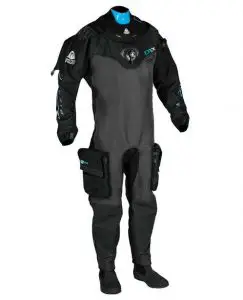Introduction
Quick Navigation
Feeling cold during diving is one of the problems divers experience, especially when wearing a wetsuit that has not yet dried or when embarking on the second or third dive. Sometimes, this feeling happens before the dive starts.
While there used to be no alternatives to wetsuits, drysuits have become more prevalent in recent years. This guide will show you the differences and application of both wetsuits and drysuits, especially for sea kayakers. Let’s begin the debate and comparison between the wetsuit and the drysuit.
What is a Wetsuit?
A wetsuit is one of the basic diving equipment used to maintain the diver’s body temperature underwater and protect the diver from coral and aquatic life. When it comes to a wetsuit, the diver usually uses the combination of Lycra or neoprene shirts and a dry jacket with a so-called long john (wetsuit with straps but without sleeves).
By diving inside water, the paddler stays dry at first, but water penetrates the neoprene over time. Nevertheless, the neoprene still offers protection against hypothermia for a certain time (depending on the water temperature and the thickness of the neoprene).
Read more on different fishing rod types and uses explained
Advantages of a Wetsuit
A wetsuit is relatively lightweight and inexpensive,
It is easy to put on and take off.
It doesn’t require much care and maintenance except for washing it with water.
In the event of a rupture or cut in the wet suit, the diver can treat it himself if he wishes by using a rubber adhesive.
A wetsuit is more durable.
Various combinations are possible (without, short or long paddler jacket)
Disadvantages of a Wetsuit
If a wetsuit doesn’t fit well, it may cause you to feel pain on your skin. Your wetsuit must fit you; it is too small for you (maybe you have gained a few more pounds), it narrows you uncomfortably. If the Neo is too big for you, too much water will run into your suit, which will also slow you down.
There is a restriction of movement. With full suits (long arms, long legs), the shoulder area’s material always restricts your movement. No matter how thin or thick it is. The lighter the material in the shoulder area, the less restricted the movement.
What is a Drysuit?
The drysuit is structurally free from inundation from the feet. The neck is also made of rubber, and most of the wrists have a double cuff with a dual structure, so there is almost no water ingress from the gloves. The water does come in a little, but it won’t get wet enough to lower the body temperature if used correctly.
The drysuit prevents water from penetrating and therefore offers longer protection against hypothermia. However, it is important that the paddler still puts on enough warm clothing underneath. Depending on the temperature, this can range from functional underwear to thermal underwear to neoprene.
Advantages of Drysuits
Drysuit offers better protection against hypothermia.
Absolute dryness
There is more comfort/freedom of movement.
Independence of clothing underneath
It is the most recommended for people who get cold always.
Disadvantages of Drysuits
The disadvantage of a dry suit is the lack of grout in the drysuit as soon as water penetrates. This can occur due to wear and tear or by tearing open on a pointed object.
It is heavier in weight.
A drysuit is more expensive.
Sometimes, it requires a lot of maintenance work, and you may need a colleague to put it on or take it off.
It is difficult to dry (water stores on the bottom because it has boots)
Manufacturer checks such as inundation checks are required regularly.
If it is a zipper-type, it may rub and hurt.
You may be interested in different types of finning techniques
Difference Between Wetsuit and Drysuit
Their differences can be measured in terms of cost, weight, maintenance cost, and warmth.
Cost
Wetsuits are cheaper than drysuits. Previously, there is a vast difference in their prices due to the design’s uniqueness and method adopted by the manufacturers.
Nowadays, the arrival of new materials and more competition has leveled the price of entry-level drysuits and high-quality wetsuits. Practically, a drysuit performs different functions, which makes it more flexible than a wetsuit.
Weight
Weight is a crucial factor sea kayakers, especially divers, considers when choosing between the dry suit and a wetsuit.
If you intend not to dive but want to stay on the surface of the water, wetsuits allow you to stay afloat with the help of neoprene. However, as you go deeper into the water, the wetsuit will contract, thereby adding more weight to your body.
For the drysuit, the buoyancy of the suit is constant. No additional weight is added to your body when you dive deeper into the water.
Warmth
People love to remain hydrated during diving because of the water temperature.
With neoprene, wetsuits allow a small amount of water on your skin, thereby making them heat up, therefore heat is maintained. That’s why the importance of wearing large wetsuits cannot be overlooked because it will flush away the warm water instead of holding the water with you.
On the other hand, the drysuit will only make you warm when you wear an undergarment underneath.
Maintenance Cost
A dry wetsuit’s maintenance method is to soak the dry wetsuit in clean water and avoid sun exposure after diving, then store in a ventilated and relaxed place as much as possible. The zipper should be lubricated frequently and should not be folded for a long time to prevent the synthetic foam rubber from causing irreversible wrinkles.
In contrary to drysuit, wetsuit requires little attention and care. The necessary thing to do is to wash after each use.
Conclusion
Wetsuit or drysuit, which one is better?
Generally, there is no answer to whether a wetsuit or a drysuit is better.
If you have been paddling at sea, going solo, or have not yet had a lot of paddling experience, it would be better to buy a drysuit because a good drysuit offers better protection against hypothermia.
Read also different types of diving weight‘

